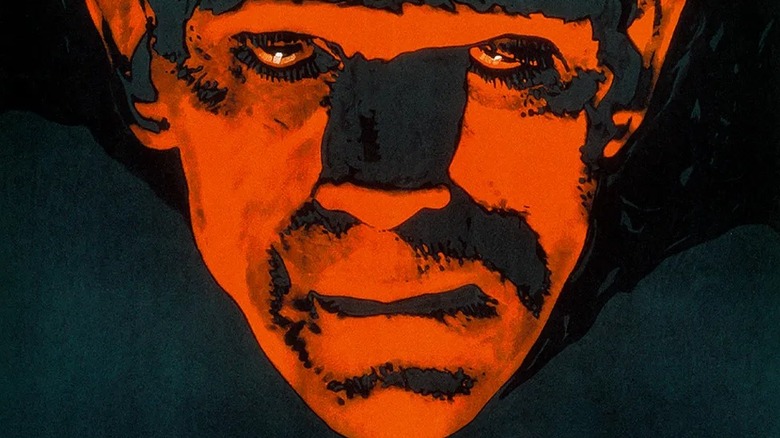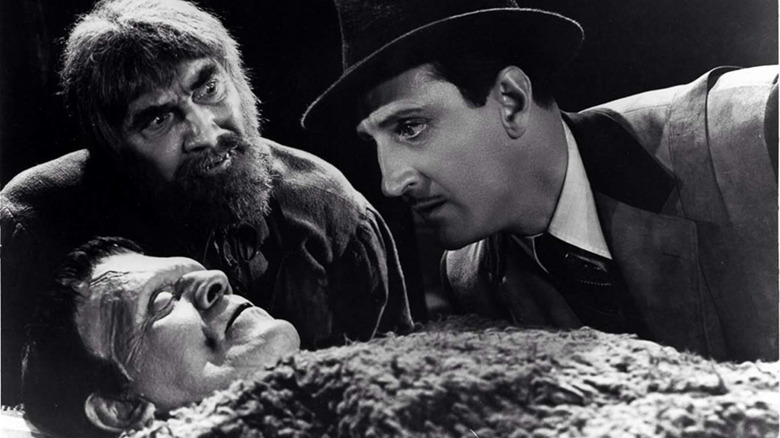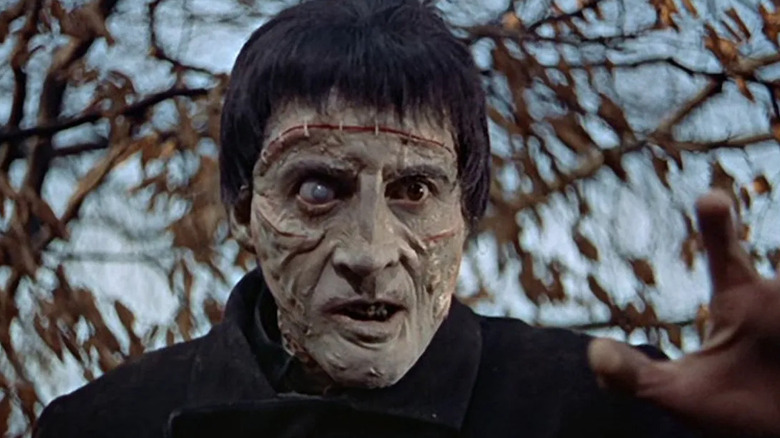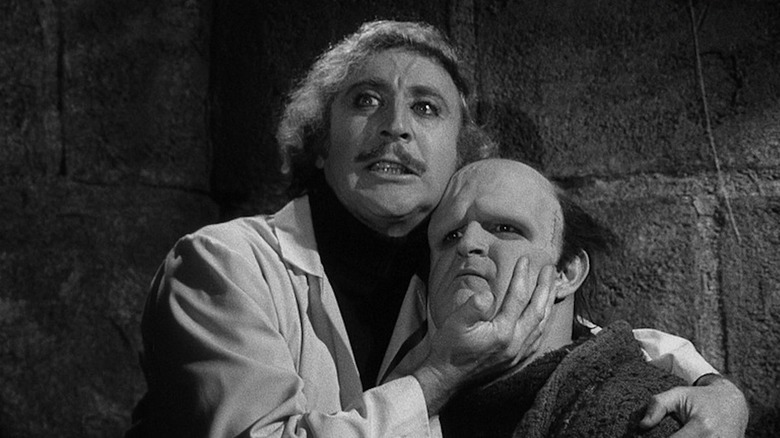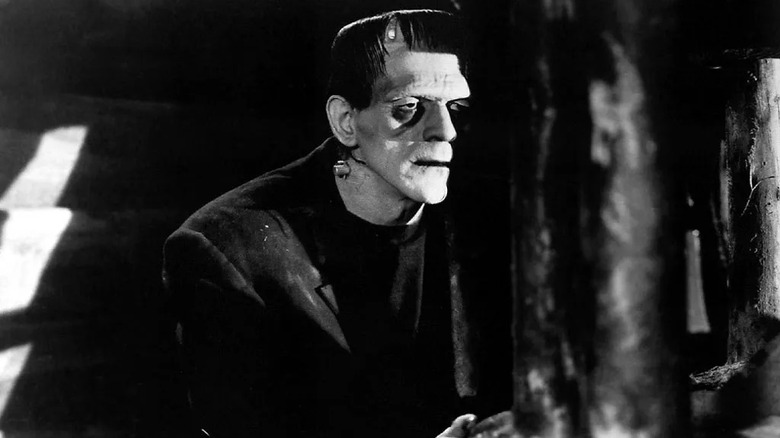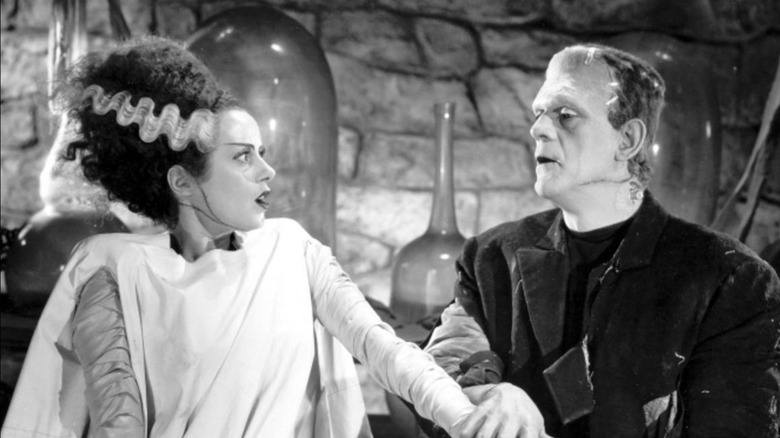The 5 Best Frankenstein Movies Ranked
There are a lot of "Frankenstein" movies. There's even one in theaters right now: "Lisa Frankenstein," a fun 80s-set horror-comedy-romance brew (read /Film's review here).
One could even say the story of "Frankenstein" birthed the horror genre as we know it today, both in literature (thanks to Mary Shelley's "Modern Prometheus") and in film. James Whale's 1931 "Frankenstein," arriving on the heels of "Dracula," cemented the age of Universal Horror and proved that monsters could be crowd-pleasers.
Countless sequels and remakes later, everyone knows the basics of the story. Dr. Frankenstein (first name usually Victor) sets out to create life in a reanimated corpse. The result is a Creature, unpleasant to the eye, and soon Frankenstein experiences the wrath of his Monster. Was Frankenstein's Monster born destructive or made that way by his creator rejecting him? Interpretations differ, but the message endures: don't play God (or become a parent) if you aren't prepared for the consequences.
Now, these are best-of-the-best "Frankenstein" films — at least until Guillermo del Toro's long-awaited "Frankenstein" hits the silver screen in 2025. (For brevity's sake, there are no spiritual "Frankenstein" adaptations like "Jurassic Park" or last year's "Poor Things" included here.)
5. Son of Frankenstein
The third Universal "Frankenstein" release, 1939's "Son of Frankenstein" split the difference on the original defining creative team. James Whale was out as director, but Karloff was still in it as the Creature (for the final time).
The tortured plot mechanics to keep this blockbuster story going are apparent. Baron Wolf von Frankenstein (Basil Rathbone), son of the late original Dr. Frankenstein (actor Colin Clive had passed away in 1937), moves his family back to his father's castle. Despite setting out to redeem the name Frankenstein, he is convinced to repeat his sire's mistake and once more try to bring the Creature to life. Director Rowland V. Lee at least recaptures Whale's atmosphere and aesthetics, if not his imagination.
The true villain, and scene-stealer, of the movie is Ygor (Bela Lugosi), a villager who survived execution by hanging and is out to avenge himself upon the townsfolk, with the monster as his instrument. Lugosi, who once turned down playing Frankenstein's Monster because it wasn't a sexy enough role, finds his humility as Ygor. Far removed from his more famous role as the regal Count Dracula, Ygor is a scruffy hunchback with the personality to match.
4. The Curse of Frankenstein
In the 1950s, British studio Hammer Films resurrected the "Frankenstein" and "Dracula" series like their undead antagonists. These reboots became as prosperous for Hammer as they had been for Universal, making stars Peter Cushing and Christopher Lee into Karloff and Lugosi for a new generation.
This all began with 1957's "Curse of Frankenstein," directed by Terence Fisher, starring Cushing as Dr. Frankenstein and Lee as the Creature. Like Whale's "Frankenstein," this one loosely hits the beats of the novel but turns the Creature into a mute monster — and in this case, Frankenstein himself from hubristic to downright evil.
The films' styles couldn't be more different, though. Hammer's gory and horny output was sensationalist counterprogramming to the Hays Code-restricted Hollywood, "Curse of Frankenstein" included. Unlike the austere black and white of Universal, Hammer's "Frankenstein" was shot in technicolor, combining the lurid and the gothic. The Creature himself looked more grotesque, with harsher makeup evoking a rotting corpse stitched together. As for performance, the difference lies in the eyes: compare Karloff's gaze of empty-headed innocence with Lee's piercing look of a predator.
3. Young Frankenstein
Even though the name evokes horror, "Frankenstein" films have a proud tradition of comedy. In 1948, Frankenstein's Creature even met the famed comedic duo Bud Abbott and Lou Costello.
The best comic "Frankenstein" film is Mel Brooks' 1974 "Young Frankenstein." A parody made with love and superbly cast, "Young Frankenstein" is one of the funniest movies ever made and still honors the spirit of the films it playfully mocks. Presented in the style of the Universal "Frankenstein" films, from the black-and-white coloring to the rustic European setting, "Young Frankenstein" mixes that defining horror aesthetic with run-on comedy; the results sing.
Though the film homages all the first three Universal "Frankenstein" films, the premise echoes "Son of Frankenstein." Gene Wilder's Dr. Frederick Frankenstein ("it's pronounced Fronken-steen") is a descendant of the original Frankenstein. After inheriting his ancestor's Transylvanian estate, he travels there and is convinced by the original Frankenstein's notes to re-attempt his experiment, resulting in a new Creature (Peter Boyle). In keeping with the "Son" homages, one of the main supporting characters (and the funniest part of the movie) is Igor — pronounced EYE-gore (Marty Feldman).
It's not all humor though. In the film's closing moments, the Creature is gifted the ability to speak and he recites lines akin to Shelley's erudite Adam: "For as long as I can remember, people have hated me. They looked at my face and my body and they ran away in horror. In my loneliness, I decided that if I could not inspire love, which was my deepest hope, I would instead cause fear!" Boyle's Creature, though, is the first one to find that love, both from his father and from a mate.
2. Frankenstein (1931)
We've finally arrived at the near century-old film that every mind jumps to whenever they hear the word "Frankenstein."
Whale's "Frankenstein" was not the first time the novel was brought to life (it had inspired both stage and silent film productions), but it has defined the story of Frankenstein since. Boris Karloff's green-skinned (on the posters), square-headed likeness as the creature, the motif of life via electricity, "It's alive!" — all begin in that film and echo across later adaptations. It's so definitive that you can forget how innovative it was for its day. Even if you already know the beats and defining images of "Frankenstein," you owe it to yourself to sit down and actually watch it.
If there's one complaint, it's that I've never been wholly satisfied by the Monster's lack of humanity compared to the novel. The Creature as written by Shelley was intelligent and capable of conversing with his creator. Whatever his faults, they didn't lie in his brain. Karloff's Creature is silent and thinks like a child. Take the scene where he plays with a young girl by a river and then accidentally drowns her because he doesn't understand the consequences of his actions. It's a stark contrast to the book, where the Creature actually saves a child from drowning, only to be shot by the child's father. When the Creature does kill a child — Frankenstein's younger brother, William — it's a purposeful act of vengeance against his creator.
This ultimately boils down to differences in the medium: A silent character is an unneeded challenge in prose, but a scarier presence on film.
1. Bride of Frankenstein
Decades before "The Empire Strikes Back," "Bride of Frankenstein" (narrowly approved by censors) was the sequel that proved itself better than the original.
With the story completed in the original "Frankenstein," Whale backtracked and improvised. He pulled two subplots from the novel, cut from the original, that both reflected the Creature's desire for companionship. The Monster befriends a blind man (Oliver Peters Heggie), the only man he's met who isn't scared by his appearance, and Dr. Frankenstein is cajoled into creating a mate for the Creature. Here though, he's blackmailed by the sinister Dr. Pretorius (Ernest Thesiger), whose affect and appearance feel like the forebear of Peter Cushing's Dr. Frankenstein. While Victor destroys the mate before she can come to life in the novel, in "Bride of Frankenstein" she awakens in all her beehive-hair glory (played by Elsa Lanchester).
While the Creature still has a primitive brain, this sequel extends him the humanity that the original didn't. There's even a framing device where Mary Shelley (Lanchester) tells the story to her husband Percy Bysshe Shelley (Douglas Walton) and Lord Byron (Gavin Gordon). It's as if Whale is conceding authorship to Shelley, assuring audiences that his film honors the spirit of her novel if not her exact words.
